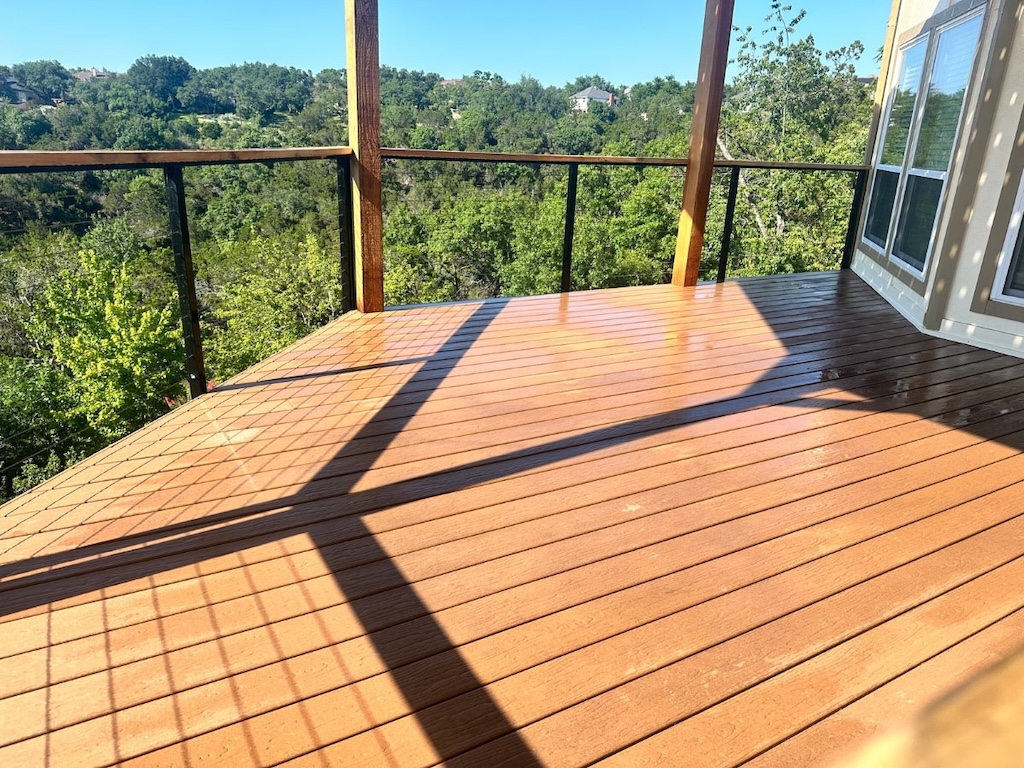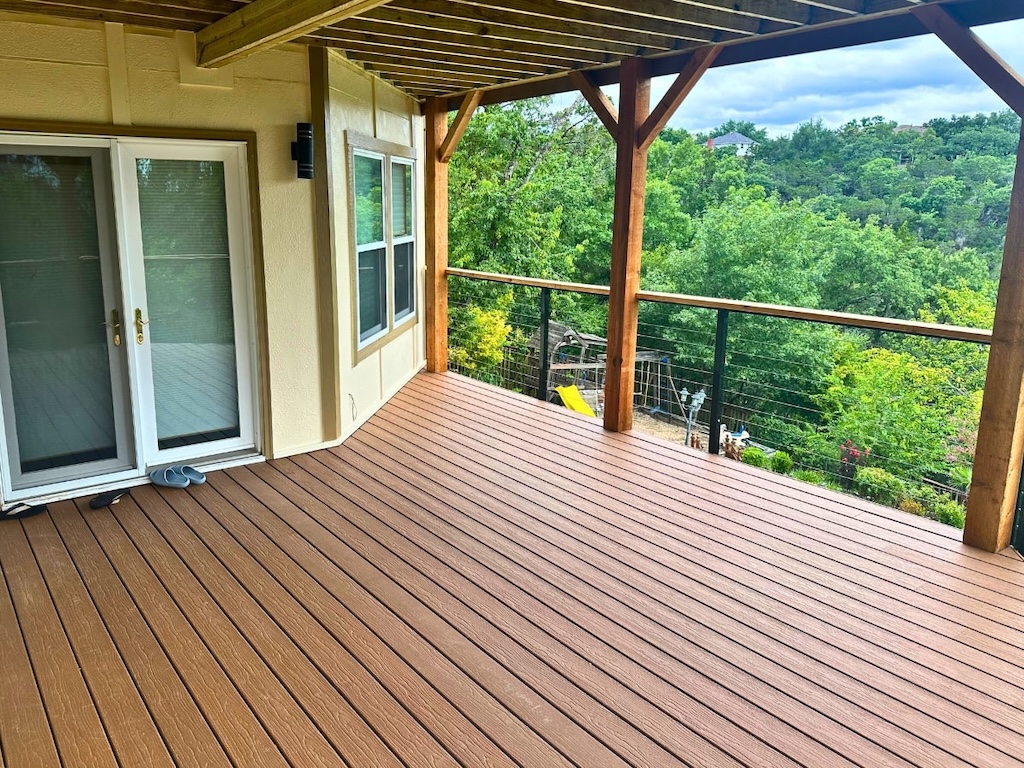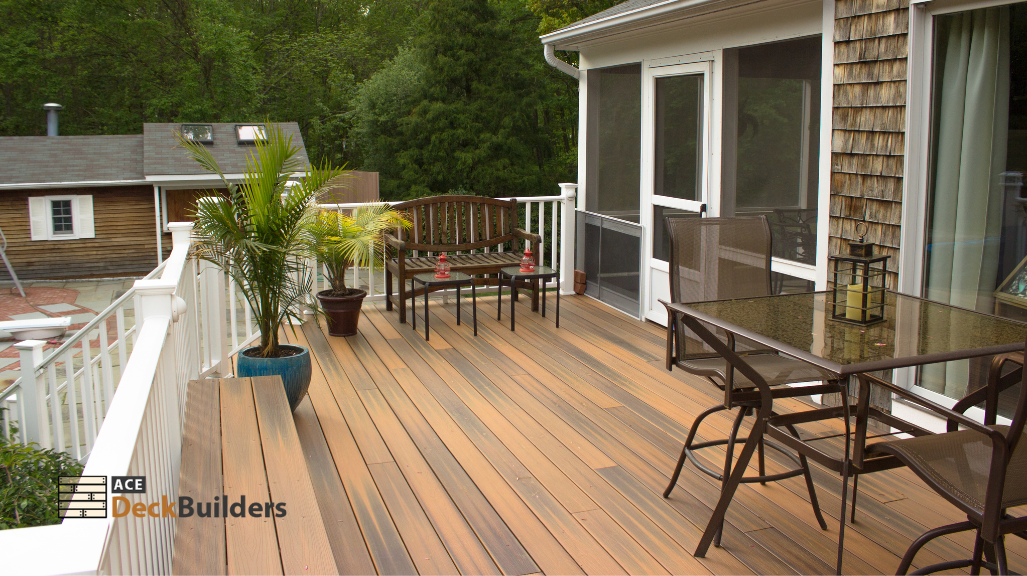TL;DR
Deck quotes vary because the scope varies. Normalize every proposal (same size, stairs, rail length, materials), demand itemized line items, and verify inspection milestones and change-order rules in writing. Ask for a sample plan, a detail sheet (ledger/footings/rail posts), and a milestone payment schedule. To see the baseline of process and craftsmanship you should expect locally from a deck contractor, start with Ace Deck Builders.
Table of Contents
ToggleWhy Deck Quotes Differ (Even for “the Same Deck”)

If you’re looking at three numbers that span thousands of dollars, the reason is rarely “one guy is cheaper.” Its scope. One proposal includes skirting and fascia, another doesn’t, making it essential when comparing deck contractor quotes. One has cable rail priced; another assumed pickets. One planned for extra piers on a slope; another guessed.
Your mission: turn vague estimates into comparable proposals by pinning down assumptions and asking specific questions. You don’t need to become a builder—you need to control the inputs and insist on clarity to make an informed decision.
Copy the “Normalization” checklist below into a notes app and run it with each contractor. You’ll see the quotes converge—and the professionals stand out.
The Normalization Playbook (Make Bids Comparable)
Tell each contractor to price the same spec:
- Size & height: overall dimensions and finished deck height from grade.
- Stairs: number of runs, approximate rise, any landings.
- Rails: total linear feet and style (pickets vs. cable vs. glass); include stair rail.
- Decking: one specific series/color plus a single alternate (e.g., “mid-range composite, light tone; alternate: PVC light tone”).
- Skirting & fascia: which sides get what, and how many linear feet.
- Footings: acknowledge slope or access constraints; assume a footing count or provide a unit cost.
- Permits/inspections: who pulls, who meets inspectors, and which inspections apply (footing, framing, final).
- Timeline: Request a Gantt with inspection hold points and weather buffer days.
- Allowances & exclusions: define both (more below).
- Warranty: workmanship term and how the manufacturer claims are handled.
Send this mini spec to every bidder. Now you’re comparing apples to apples.
In Items You Should See on Every Proposal
If a quote is just a single number, you’re blind to scope. A reliable proposal itemizes:
- Framing: species/size, beam/joist layout, blocking at rail posts & stairs
- Decking: brand/series/color, board count or square footage, fastener system (hidden/plug)
- Rails: style, brand/components, linear feet (level & stair)
- Stairs: number of runs, landings, handrails (graspable), nosing/tread details
- Fascia & skirting: coverage and ventilation plan for low decks
- Hardware: ledger fasteners/flashing, post bases, hangers, corrosion class (stainless at pools)
- Lighting (if included): fixture count, driver locations, trim vs. rough
- Demo & haul-off (for replacements)
- Permits/inspections: included administrative time and site meeting responsibility
- Cleanup & protection: surface/landscape protection, daily housekeeping
- Closeout: care & cleaning guide, stain schedule if wood, warranty contacts
Ask for a detailed sheet image or PDF. Ten minutes reviewing a ledger/footing/rail post detail, including the decking materials, tells you more than an hour of sales talk.
Allowances, Exclusions & Hidden Costs (Read These Twice)

Allowances are provisional amounts for unknowns. They prevent padded pricing—but only if realistic.
- Standard allowances: rock excavation, extra piers, hidden rot, access protection, and tree root mitigation.
- Request the unit pricing behind an allowance (e.g., “$X per additional pier”).
- Ensure material costs are tied to named series (not “mid-grade composite”).
Exclusions define what’s not included (important!). Typical exclusions: irrigation repairs, landscaping restoration, furniture/grills, natural wood HOA fees, and engineering stamps (when not required).
While evaluating scope quality, it helps to visualize the professional build arc—drawings, submittals, inspections, and punch list. A quick mid-research reference is the service overview for deck installation in Austin, which explains how pros structure timelines around local building codes and inspections.
Schedule Truths: Permits, Inspections & Hold Points
In Austin, most projects will have at least three inspection gates:
- Footings – depth/diameter and soil conditions verified before concrete.
- Framing – ledger flashing, fastener patterns, joist spans, and rail post connections are exposed before decking hides them.
- Final – rail height, stair geometry, electrical trim (if any), and overall safety.
Quotes should show a Gantt with those hold points, plus weather buffers and HOA review time if applicable. Ask for recent inspection tags or pass notes from a similar job that uses low-maintenance materials.
If you’re contemplating a refresh instead of a complete rebuild, or want a more profound sense of how pros evaluate safety/code before pricing, to ensure you’re working with an experienced contractor, review a plain-English walkthrough of deck inspection in Austin to see what a thorough evaluation looks like.
Payment Terms, Change Orders & Warranty Language
Milestone billing is healthy for both sides. Typical pattern:
- Small deposit
- Draw at permit approval
- Draw at material delivery
- Draw a framing inspection pass
- Final at substantial completion (or after final inspection)
Change orders must be written, and pause work until you approve the price and timeline impact. No verbal “we’ll figure it out.”
Warranty: Ask for workmanship in writing (1–3 years is common) and confirm who handles manufacturer claims if a board issue occurs later.
Materials, Rails & Stairs: The Real Cost Drivers
- Rails are the budget fulcrum. Cable/glass are premium; pickets are value wins. A lot of the price spread between quotes is rail type/length.
- Stairs add layout time, stringer cuts, blocking, and code checks. Consolidating to one well-placed run saves dollars.
- Decking series & color matter for both budget and comfort. Lighter tones run cooler in Austin sun; some premium lines include heat-mitigation tech and more extended warranties.
- Skirting/fascia finishes the look but adds linear-foot costs—specify exactly where you want them.
For a side-by-side on board categories and how they behave (heat, maintenance, warranties), it’s helpful to scan a homeowner’s guide to the best types of deck materials, leveraging the expertise before you finalize the spec you send to bidders.
How to Interview Contractors (Scripts & Questions)

Use these word-for-word prompts. You’ll learn quickly who’s prepared.
Plan & Details
- “Can you show a recent plan set and your standard detail sheet for ledger/footings/rail posts?”
- “What joist spacing are you planning for this board series?”
Permits & Inspections
- “Who pulls the permit and meets inspectors for footing, framing, and final?”
- “What will be visible at framing inspection so it passes first try?”
Scope & Pricing
- “Please itemize framing, decking series, rails (LF), stairs, skirting/fascia, and lighting.”
- “What are the allowances? What are the exclusions?”
Schedule & Communication
- “Share a Gantt with inspection hold points and weather buffers.”
- “Who is my single point of contact, and how often will I get updates?”
Warranty & Closeout
- “What is your workmanship warranty? Who helps with manufacturer claims?”
- “What’s in the closeout packet (care/cleaning, stain schedule, warranty contacts)?”
Need a broader hiring lens to complement this list? Skim the quick homeowner primer on questions to ask before hiring a deck builder and combine it with the normalization checklist you’re using here. And combine it with the normalization checklist you’re using here.
Red Flags (Walk Away If You See These)
- One-line quotes with no specs
- “No permit needed” on obvious permit jobs
- Dodging requests for a detail sheet or inspection tags
- Heavy front-loaded payments before permits/materials
- Vague warranty or exclusions that gut coverage
- Unclear change-order process (“we’ll talk about it later”)
Quote Comparison Template (Scorecard)
Print this table or drop it into a spreadsheet. Score each category 1–5.
| Category | What to Check | Score (1–5) |
|---|---|---|
| Plan & Details | Plan set provided; ledger/footing/rail post detail shown | |
| Permits/Inspections | Clear responsibility + Gantt with hold points | |
| Structure | Span tables matched to the board; blocking at rails/stairs. | |
| Materials | Named board series; rail style & LF; skirting/fascia coverage | |
| Scope Clarity | Itemized line items; realistic allowances; clear exclusions | |
| Schedule | Weather buffers; inspection prep called out | |
| Warranty | Workmanship in writing; manufacturer claim support | |
| Communication | Single PM; weekly updates; documented channels | |
| Price Integrity | Change-order rules; milestone billing; no vague fees |
Decision rule: If two prices are close, pick the team with better artifacts (plans, details, schedule). Those are leading indicators of a painless build.
FAQs
Rails combine structural safety with finish work: posts, blocking, hardware, infill, and code checks. Linear feet and style (cable/glass vs. pickets) swing budgets more than most homeowners expect.
Often, yes, in Austin. Engineered boards reduce maintenance and keep their appearance stable. If barefoot comfort is key, choose lighter tones and plan some shade.
Three serious, itemized bids are plenty. Past that, you lose time to scope reconciliation.
Only if the frame meets current span/spacing tables, has proper ledger flashing, and passes inspection. Many older frames need upgrades.
Milestones tied to progress: permit approval, material delivery, framing inspection pass, substantial completion—not heavy front-loading.
Get an Apples-to-Apples Deck Quote
Want a decision-ready proposal with itemized pricing, named materials, inspection hold points, and clear allowances/exclusions? Start with a free deck estimate in Austin and get a plan to compare confidently against other deck contractor quotes —no guesswork.
